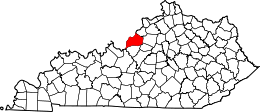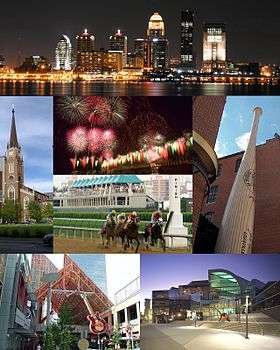Glenview, Kentucky
| Glenview, Kentucky | |
|---|---|
| City | |
 Glenview, Kentucky Location within the state of Kentucky | |
| Coordinates: 38°18′22″N 85°39′13″W / 38.30611°N 85.65361°WCoordinates: 38°18′22″N 85°39′13″W / 38.30611°N 85.65361°W | |
| Country | United States |
| State | Kentucky |
| County | Jefferson |
| Named for | Glen View, a former horse farm |
| Area | |
| • Total | 1.4 sq mi (3.7 km2) |
| • Land | 1.4 sq mi (3.7 km2) |
| • Water | 0.0 sq mi (0.0 km2) |
| Elevation | 449 ft (137 m) |
| Population (2000) | |
| • Total | 558 |
| • Density | 386.3/sq mi (149.2/km2) |
| Time zone | Eastern (EST) (UTC-5) |
| • Summer (DST) | EDT (UTC-4) |
| ZIP code | 40025 |
| Area code(s) | 502 |
| FIPS code | 21-31348 |
| GNIS feature ID | 0508100 |
|
Glenview Historic District | |
  | |
| Location | Glenview Ave., Louisville, Kentucky |
| Area | 80 acres (32 ha) |
| Architect | Multiple |
| Architectural style | Late 19th And 20th Century Revivals |
| MPS | Jefferson County MRA |
| NRHP Reference # | 83002673[1] |
| Added to NRHP | August 16, 1983 |
Glenview is a 6th-class city along the southern bank of the Ohio River in northeastern Jefferson County, Kentucky, United States The population was 558 at the 2000 census and was estimated to have increased to 718 by the 2006 census estimate.[2]
Glenview has the 2nd-highest per capita income within Kentucky and the 74th-highest in the United States. Its boundaries are roughly Lime Kiln Lane to the east, River Road to the north, Brittany Woods Circle to the south and the Knights of Columbus property on River Road to the west. The city is known for its old estate homes on high bluffs overlooking the Ohio River.
History
5000 acres of the surrounding land was originally owned by James Smalley Bate and named Berry Hill for his former Virginia home. The estate was purchased in 1868 by meat packer James C. McFerran. McFerran's horse farm was named Glen View. After his death in 1885, John E. Green acquired the farm and renamed it Glenview Stock Farm. The community received its post office on May 11, 1893.[3]
In the late 19th century, wealthy families from Louisville began moving east to build summer homes in communities such as Anchorage. Some of these eventually became full-time residences. Early residents of Glenview cooperated with other communities to open the Louisville, Harrods Creek and Westport Railroad in 1877, a commuter rail line in use until its abandonment in the 1950s. Some of Louisville's most influential families, including the Binghams, the Ballards, and the Belknaps, moved into the area after the opening of the railroad. Some developers have played off Glenview's reputation, establishing similarly-named communities at Glenview Manor and Glenview Hills in the 1960s and 70s.
Louisville attempted to annex Glenview in 1983, which prompted its residents to seek a separate incorporation from the state legislature. This was granted in 1985.[4] Many of the houses are part of the Glenview Historic District, which is on the National Register of Historic Places.
Geography
Glenview is located at 38°18′22″N 85°39′13″W / 38.30611°N 85.65361°W (38.306069, -85.653640).[5]
According to the United States Census Bureau, the city has a total area of 1.4 square miles (3.6 km2), all land.
Demographics
| Historical population | |||
|---|---|---|---|
| Census | Pop. | %± | |
| 1990 | 653 | — | |
| 2000 | 558 | −14.5% | |
| 2010 | 531 | −4.8% | |
| Est. 2015 | 544 | [6] | 2.4% |
As of the census[8] of 2000, there were 558 people, 214 households, and 181 families residing in the city. The population density was 386.3 people per square mile (149.6/km²). There were 232 housing units at an average density of 160.6 per square mile (62.2/km²). The racial makeup of the city was 96.24% White, 0.18% Native American, 2.69% Asian, 0.18% Pacific Islander, 0.72% from other races. Hispanic or Latino of any race were 1.08% of the population.
There were 214 households out of which 34.1% had children under the age of 18 living with them, 81.8% were married couples living together, 2.3% had a female householder with no husband present, and 15.0% were non-families. 13.1% of all households were made up of individuals and 6.5% had someone living alone who was 65 years of age or older. The average household size was 2.61 and the average family size was 2.84.
In the city the population was spread out with 22.4% under the age of 18, 5.2% from 18 to 24, 13.3% from 25 to 44, 42.5% from 45 to 64, and 16.7% who were 65 years of age or older. The median age was 48 years. For every 100 females there were 97.2 males. For every 100 females age 18 and over, there were 94.2 males.
The median income for a household in the city was $161,571, and the median income for a family was $183,800. Males had a median income of $100,000 versus $46,250 for females. The per capita income for the city was $85,094. About 3.3% of families and 4.2% of the population were below the poverty line, including 6.5% of those under age 18 and none of those age 65 or over.
See also
References
- ↑ National Park Service (2010-07-09). "National Register Information System". National Register of Historic Places. National Park Service.
- ↑ "Subcounty population estimates: Kentucky 2000-2006" (CSV). United States Census Bureau, Population Division. 2007-06-28. Retrieved 2008-05-28.
- ↑ Rennick, Robert. Kentucky Place Names, pp. 117–118. "Glenview". University Press of Kentucky (Lexington), 1987. Accessed 28 Jul 2013.
- ↑ Commonwealth of Kentucky. Office of the Secretary of State. Land Office. "Glenview, Kentucky". Accessed 28 Jul 2013.
- ↑ "US Gazetteer files: 2010, 2000, and 1990". United States Census Bureau. 2011-02-12. Retrieved 2011-04-23.
- ↑ "Annual Estimates of the Resident Population for Incorporated Places: April 1, 2010 to July 1, 2015". Retrieved July 2, 2016.
- ↑ "Census of Population and Housing". Census.gov. Archived from the original on May 11, 2015. Retrieved June 4, 2015.
- ↑ "American FactFinder". United States Census Bureau. Retrieved 2008-01-31.
Further reading
- A Place in Time: The Story of Louisville's Neighborhoods. Louisville. 1989.
External links
- "Glenview: Exclusive Estates on the Bluff Catered to Those Retreating to the Resplendent and Reclusive" — Article by Phyllis Hurd of The Courier-Journal

